2003 CHEVROLET ASTRO radiator
[x] Cancel search: radiatorPage 254 of 386
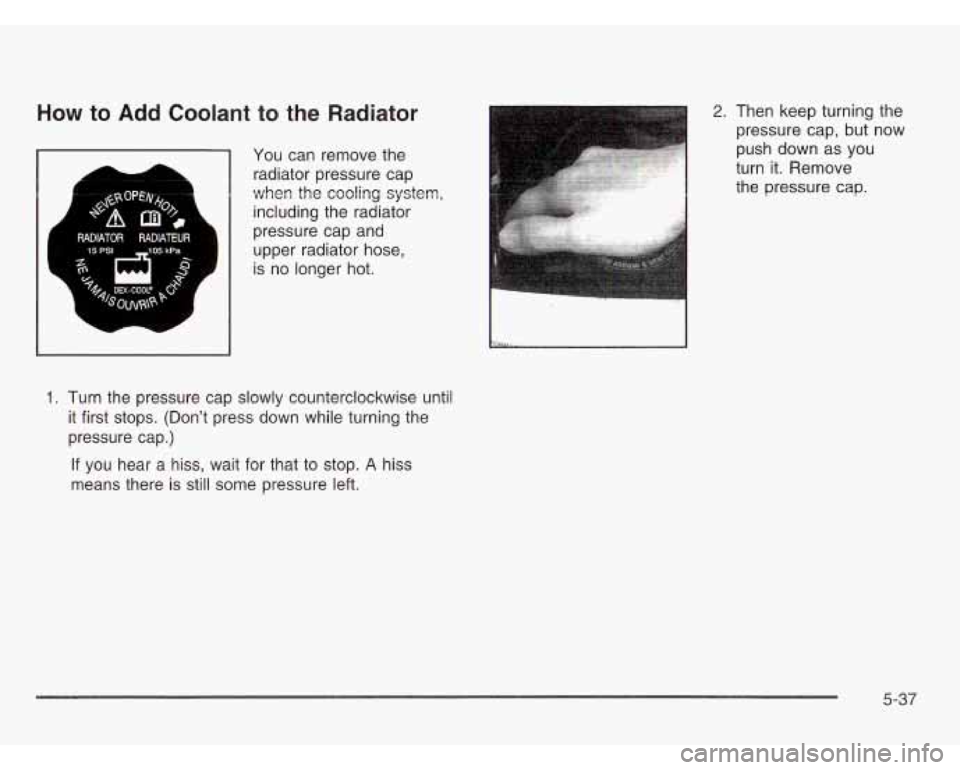
How to Add Coolant to the Radiator
You can remove the
radiator pressure cap
when the cooling system,
including the radiator
pressure cap and
upper radiator hose,
is no longer hot.
1. Turn the pressure cap slowly counterclockwise until
it first stops. (Don't press down while turning the
pressure cap.)
2. Then keep turning the pressure cap, but now
push down as you
turn it. Remove
the pressure cap.
If you hear a hiss, wait for that
to stop. A hiss
means there is still some pressure left.
5-37
Page 255 of 386
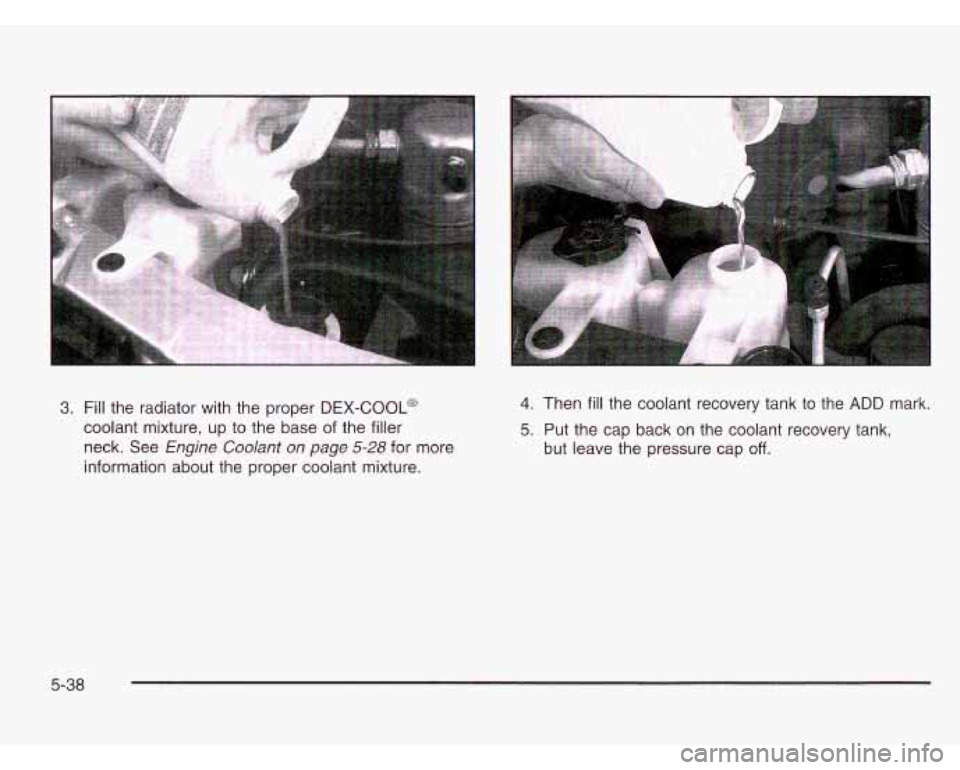
3. Fill the radiator with the proper DEX-COOL@
coolant mixture, up to the base of the filler
neck. See
Engine Coolant on page 5-28 for more
information about the proper coolant mixture.
4. Then fill the coolant recovery tank to the ADD mark.
5. Put the cap back on the coolant recovery tank,
but leave the pressure cap
off.
5-38
Page 256 of 386
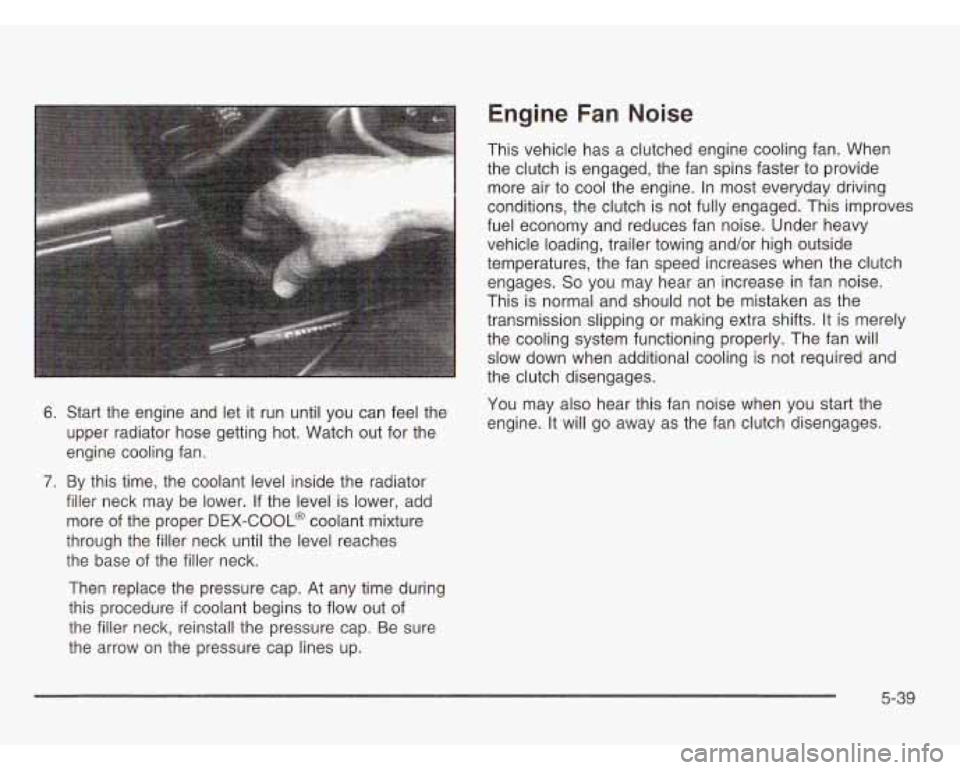
6. Start the engine and let it run until you can feel the
upper radiator hose getting hot. Watch out for the
engine cooling fan.
7. By this time, the coolant level inside the radiator
filler neck may be lower.
If the level is lower, add
more of the proper
DEX-COOL@ coolant mixture
through the filler neck until the level reaches
the base of the filler neck.
Then replace the pressure cap. At any time during
this procedure
if coolant begins to flow out of
the filler neck, reinstall the pressure cap. Be sure
the arrow on the pressure cap lines up.
Engine Fan Noise
This vehicle has a clutched engine cooling fan. When
the clutch is engaged, the fan spins faster to provide
more air to cool the engine. In most everyday driving
conditions, the clutch is not fully engaged. This improves
fuel economy and reduces fan noise. Under heavy
vehicle loading, trailer towing and/or high outside
temperatures, the fan speed increases when the clutch
engages.
So you may hear an increase in fan noise.
This is normal and should not be mistaken as the
transmission slipping or making extra shifts. It is merely
the cooling system functioning properly. The fan will
slow down when additional cooling is not required and
the clutch disengages.
You may also hear this fan noise when you start the
engine. It will go away as the fan clutch disengages.
5-39
Page 337 of 386

100,000 Miles (166 000 km)
0 Inspect spark plug wires. An Emission Control
Service.
0 Replace spark plugs. An Emission Control Service.
0 If you haven’t used your vehicle under severe service
conditions listed previously and, therefore, haven’t
changed your automatic transmission fluid, change
both the fluid and filter.
0 Change transfer case fluid.
Cl Inspect Positive Crankcase Ventilation (PCV) valve.
An Emission Control Service.
150,000 Miles (240 000 km)
0 Drain, flush and refill cooling system (or every
60 months since last service, whichever occurs first).
See
Engine Coolant on page 5-28 for what to use.
Inspect hoses. Clean radiator, condenser, pressure
cap and neck. Pressure test cooling system and
pressure cap.An
Emission Control Service.
An Emission Control Service.
Cl Inspect engine accessory drive belt.
Long Trip/Highway Scheduled
Maintenance
The services shown in this schedule up to 100,000 miles
(166 000 km) should be repeated after 100,000 miles
(166 000 km) at the same intervals for the life of
this vehicle. The services shown at
150,000 miles
(240 000 km) should be repeated at the same interval
after
150,000 miles (240 000 km) for the life of this
vehicle.
See
Part 5: Owner Checks and Services on page 6-26
and Part C: Periodic Maintenance Inspections on
page 6-30.
Footnotes
t The U.S. Environmental Protection Agency or the
California Air Resources Board has determined that the
failure to perform this maintenance item will not nullify the emission warranty or limit recall liability prior to
the completion of the vehicle’s useful life. We, however,
urge that all recommended maintenance services be
performed at the indicated intervals and the
maintenance be recorded.
# Lubricate the front suspension, ball joints and kingpin
bushings, steering linkage and transfer case shift linkage,
parking brake cable guides and brake pedal springs.
+ A good time to check your brakes is during tire
rotation. See Brake System Inspection
on page 6-31.
6-1 8
Page 344 of 386

97,500 Miles (162 500 km)
U Change engine oil and filter (or every 12 months,
0 Lubricate chassis components (or every 12 months,
0 Check readfront axle fluid level and add fluid as
whichever occurs first).
An Emission Control Service.
whichever
occurs first). (See footnote #).
needed. Check constant velocity joints and axle seals
for leaking.
page 5-64 for proper rotation pattern and additional
information.
(See footnote +).
0 Rotate tires. See Tire Inspection and Rotation on
100,000 Miles (166 000 km)
0 Inspect spark plug wires. An Emission Control
U Replace spark plugs. An Emission Control Service.
Service.
0 If you haven’t used your
vehicle under severe service
conditions listed previously and, therefore, haven’t
changed your automatic transmission fluid, change
both the fluid and filter.
150,000 Miles (240 000 km)
U Drain, flush and refill cooling system (or every
60 months since last service, whichever occurs first).
See
Engine Coolant on page 5-28 for what to use.
inspect hoses. Clean radiator, condenser, pressure
cap and neck. Pressure test the cooling system
and pressure cap.
An Emission Control Service.
U Inspect engine accessory drive belt. An Emission
Control Service.
0 Change transfer case fluid.
0 Inspect Positive Crankcase Ventilation (PCV) valve.
An Emission Control Service.
6-25
Page 349 of 386
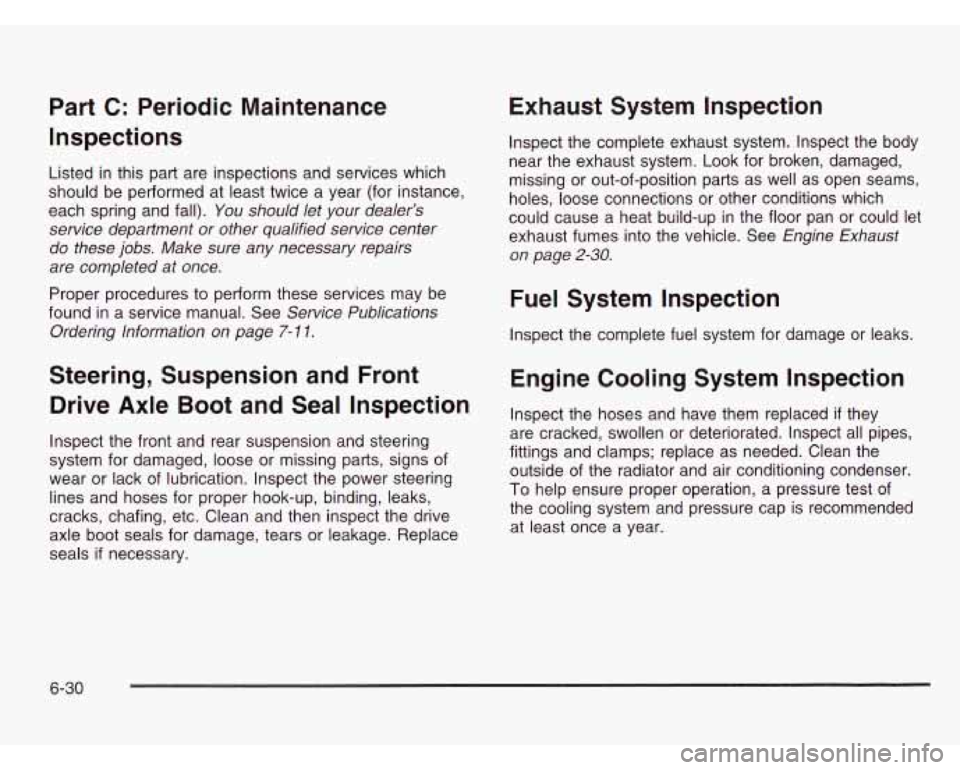
Part C: Periodic Maintenance
Inspections
Listed in this part are inspections and services which
should be performed at least twice a year (for instance,
each spring and fall).
You should let your dealer’s
service department or other qualified service center
do these jobs. Make sure any necessary repairs
are completed at once.
Proper procedures to perform these services may be
found in a service manual. See
Service Publications
Ordering Information on page
7- 1 1.
Steering, Suspension and Front
Drive Axle Boot and Seal Inspection
Inspect the front and rear suspension and steering
system for damaged, loose or missing parts, signs of
wear or lack of lubrication. Inspect the power steering
lines and hoses for proper hook-up, binding, leaks,
cracks, chafing, etc. Clean and then inspect the drive
axle boot seals for damage, tears or leakage. Replace
seals
if necessary.
Exhaust System Inspection
Inspect the complete exhaust system. Inspect the body
near the exhaust system.
Look for broken, damaged,
missing or out-of-position parts as well as open seams,
holes, loose connections or other conditions which
could cause a heat build-up in the floor pan or could let
exhaust fumes into the vehicle. See
Engine Exhaust
on page
2-30.
Fuel System Inspection
Inspect the complete fuel system for damage or leaks.
Engine Cooling System Inspection
Inspect the hoses and have them replaced if they
are cracked, swollen or deteriorated. Inspect all pipes,
fittings and clamps; replace as needed. Clean the
outside of the radiator and air conditioning condenser.
To help ensure proper operation, a pressure test of
the cooling system and pressure cap is recommended
at least once a year.
6-30
Page 373 of 386

Gasoline Octane
........................................................ 5-5
Specifications
............................................... 5-5
Gate Operator and Canadian Programming
........ 2-36
Glass Surfaces
............................................... 5-85
GM Mobility Program for Persons with
Disabilities
.................................................... 7-5
Hatch R
H
e I' ease ......................... ........ 2-15
Hazard Warning Flashers
............................... 3-4
Head Restraints
............................................... 1-5
Headlamp High/Low-Beam Changer
.................... 3-7
Headlamp Wiring
............................................ 5-92
Headlamps
.................................................... 5-55
Bulb Replacement
.................................... 5-55
Front Turn Signal Lamps
.................. ..... 5-59
Halogen Bulbs
............................ ........ 5-55
Highway Hypnosis
........................................... 4-22
Hill and Mountain Roads
.................................. 4-22
Hitches
.......................................................... 4-36
HomeLink Transmitter, Programming
.................. 2-35
HomeLink@ Transmitter
.................................... 2-34
Hood Checking Things Under
................................ 5-1 1
Release
..................................................... 5-1 1
Horn
............................................................... 3-5 How
to Add Coolant to the Coolant
How to Add Coolant to the Radiator
.................. 5-37
How to Add Fluid
............................................ 5-27
How to Check
........................................ 5-25, 5-64
How to Check Lubricant
................................... 5-53
How to Check Power Steering Fluid
.................. 5-40
How to Use This Manual
...................................... ii
Recovery Tank ........................................ 5-34
How to Wear Safety Belts Properly
................... 1-18
Hydroplaning
.................................................. 4-18
I
If No Steam Is Coming From
Your Engine
............................................ 5-32
If Steam Is Coming From Your Engine ........... 5-31
If the Light
Is Flashing ..................................... 3-32
If the Light
Is On Steady ................................. 3-32
If You Are Stuck in Sand, Mud, Ice or Snow
....... 4-28
If You Do Decide
To Pull A Trailer ..................... 4-32
If You're Caught in a Blizzard ........................... 4-26
Ignition Transmission Lock Check
...................... 6-29
Infants and Young Children, Restraints
............... 1-38
Inflation
- Tire Pressure ................................... 5-64
Inspection Brake System
............................................. 6-31
Engine Cooling System
................................ 6-30
Ignition Positions
............................................. 2-19
6
Page 377 of 386
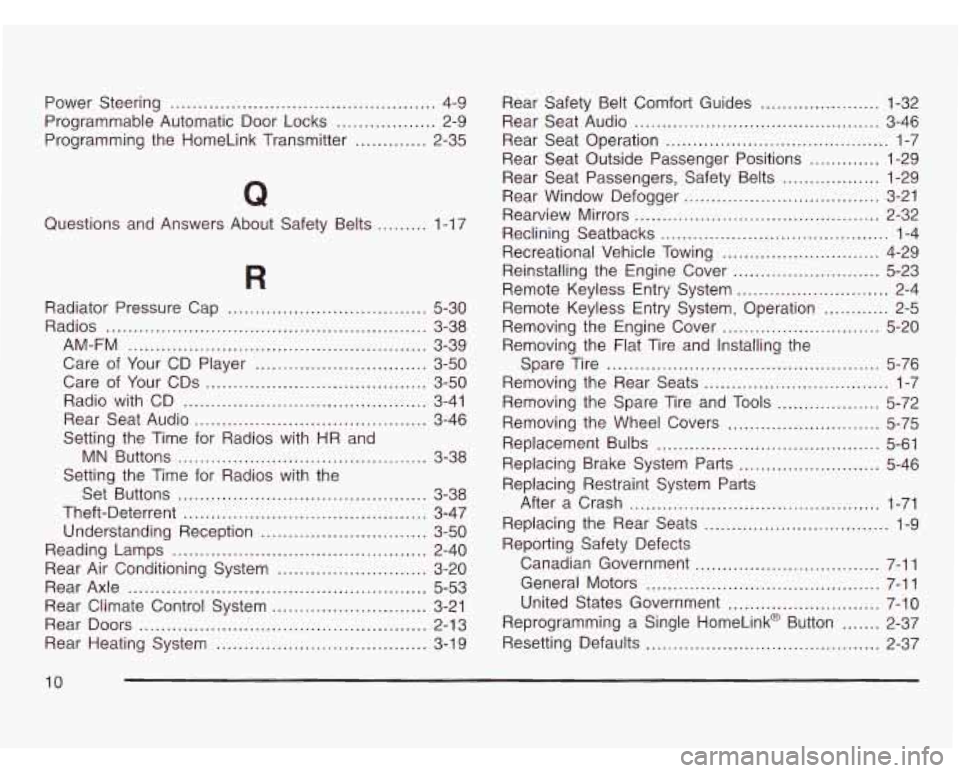
Power Steering ................................................ 4-9
Programming the HomeLink Transmitter
............. 2-35
Programmable Automatic Door Locks
.................. 2-9
Q
Questions and Answers About
Safety Belts ......... 1-17
R
Radiator Pressure Cap ................. ............ 5-30
Radios
....................................... ............ 3-38
AM-FM
....................................... ........ 3-39
Care of Your CD Player
........................... 3-50
Care of Your CDs
.................................... 3-50
Radio with CD
............................................ 3-41
Rear Seat Audio
.......................................... 3-46
Setting the Time for Radios with HR and
MN Buttons
......................................... 3-38
Setting the Time for Radios with the
Set Buttons
............................. ........ 3-38
Theft-Deterrent
........................ ........ 3-47
Understanding Reception
.......................... 3-50
Reading Lamps
.............................................. 2-40
Rear Air Conditioning System
........................... 3-20
Rear Axle
...................................................... 5-53
Rear Climate Control System
............................ 3-21
Rear Doors
.................................................... 2-13
Rear Heating System
...................................... 3-19 Rear
Rear
Rear Rear
Rear
Rear Safety Belt
Comfort Guides
...................... 1-32
Seat Audio
............................................. 3-46
Seat Operation
......................................... 1-7
Seat Outside Passenger Positions
............. 1-29
Seat Passengers, Safety Belts
.................. 1-29
Window Defoqqer
.................................... 3-21
Rearview Mirrors 2-32 -- .............................................
Reclining Seatbacks .......................................... 1-4
Recreational Vehicle Towing
............................. 4-29
Reinstalling the Engine Cover
........................... 5-23
Remote Keyless Entry System
............................ 2-4
Remote Keyless Entry System, Operation
............ 2-5
Removing the Engine Cover
............................. 5-20
Removing the Flat Tire and Installing the
Spare Tire
.................................................. 5-76
Removing the Rear Seats
.................................. 1-7
Removing the Spare Tire and
Tools ................... 5-72
Removing the Wheel Covers
............................ 5-75
Replacement Bulbs
......................................... 5-61
Replacing Brake System Parts
.......................... 5-46
Replacing Restraint System Parts
After a Crash
.............................................. 1-71
Replacing the Rear Seats
.................................. 1-9
Reporting Safety Defects Canadian Government
.................................. 7-11
General Motors
........................................... 7-11
United States Government
............................ 7-10
Reprogramming a Single HomeLink@ Button
....... 2-37
Resetting Defaults
........................................... 2-37
10